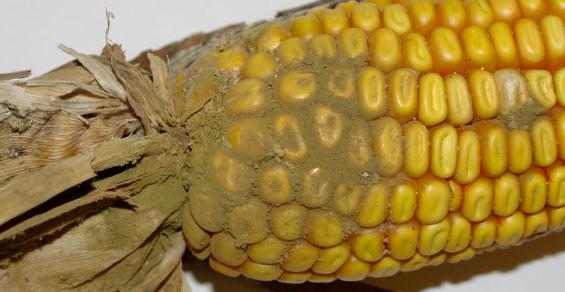Even though corn was planted later in many parts of the Corn Belt this year, it looked pretty good — except in far western areas — heading toward harvest, despite high temperatures and dry conditions early. Where they fell, timely rains during grain fill probably saved the crop. However, it is smart to pay attention to the crop until it is harvested. Stalk and ear rots always lurk in the background, and can hurt a good crop.
Stalk rots and ear rots try to spoil the fun before harvest each year. What are the most important late-season corn diseases year in and year out?
Anthracnose. There is a leaf blight phase, but it was scarce in most areas. Still, stalks of plants weakened by other leaf diseases can also be affected by this fungus, since its spores persist in the soil — especially in corn after corn and no-till. The stalk rot phase infects stalks by spores being splashed from the soil to the lower internodes of stalks. Anthracnose makes shiny black spots on stalks that look like shoe polish. Stalks become black inside, rot and go down.
Diplodia and gibberella. These diseases can infect both ears and stalks. Diplodia produces a whitish-gray fungus that starts at the base of the ears and spreads through the whole ear. Gibberella ear rot is produced by a pink fungus that generally starts at the tips. It can produce mycotoxin known as fumonisins. Affected grain should be tested before feeding livestock. Both diplodia and gibberella can cause stalk lodging and lots of yield loss if corn is not harvested on time. Hybrids differ in their tolerance to these pathogens. Disease-tolerant hybrids are available.
WHITE AND PINK: Two colors mean two molds. The two ears on the left display signs of diplodia ear rot with a white color. Gibberella, on the right, produces a pinkish mold.
Fusarium. This ear rot causes whitish-gray discoloration of groups of kernels or individual kernels scattered across the ear. They start at the point of silk attachment and can look like a starburst pattern.
Other diseases. More diseases that can damage kernels are possible. Aspergillus ear rot affects scattered kernels with a dusty olive-green color. Penicillium ear rot produces a dark green to bluish mold that can be on the ear tips or scattered on the ear. Trichoderma ear rot makes a dark green to bluish mold that can grow between the kernels.
DISEASES AND MORE: These ears are affected by multiple molds — notice the various colors. However, the root cause was western bean cutworm damage, which opened up areas for infection.
Aspergillus can produce aflatoxins. Many elevators screen for minute levels of this disease. More common after dry summers, corn with higher-than-allowable levels of aflatoxin may be discounted or even rejected at the elevator.
Crop scouting starts at emergence and does not end until the crop is in the bins. Watch for these diseases when scouting all the way to harvest. If you find significant levels of one or more of these diseases, it may require careful stewardship of the grain to make sure animals or humans aren’t affected by toxins that could be produced.
Nanda is director of genetics for Seed Genetics Direct, Jeffersonville, Ohio. Email [email protected] or call 317-910-9876. Please leave a message.
Corn Illustrated: Here’s the scoop on late-season fungus and mold to scout for.



